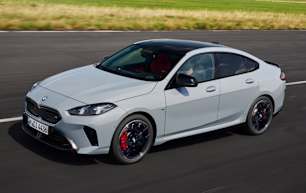Earlier, we mentioned that the 2 Series Gran Coupe is way more expensive than fine alternative sedans like the Mazda3 and Toyota Corolla.
And while that still stands, there is a remarkable solidity and refinement difference between those and the BMW that helps justify the premium. And nowhere is this more evident than from behind the wheel.
Sat on body-hugging seats and clutching that (too chunky) steering wheel, there is a sense of sporty occasion, backed up by quality trim and an aroma of expensiveness.
For a turbo three-cylinder car weighing 1.5 tonnes, the 218 does a lot with a little, offering spirited off-the-line acceleration and pleasingly lag-free throttle responses at lower speeds. You’d never call it fast, but it is a quick point-to-point urban mover. Only the unavoidable three-pot thrum lets you know you’re in the lowest mechanical spec. And, also, the delay at freeway speeds in building momentum when overtaking.
Which is why, for less than five per cent extra, the 220 with the 2.0-litre four-cylinder turbo would probably make a better buy. Sadly, that isn’t on sale yet in Australia, so we missed out on driving it during the Sydney launch. But in the scores of other BMWs and Minis we’ve tested this in, it’s a cracking little powertrain.
Whether the big leap (nearly $25K worth) to the M235 is worth it depends on how fast you drive and how much you value/need AWD. This is a terrifically muscular machine, since it provides rapid performance via a tidal wave of power, even with the lightest flex of your right foot. On-point and on-brand, this fun and fiery flagship possesses the grand-touring spirit that the rakish design and tech-heavy engineering promise.
To that end, in both the 218 and M235, the steering makes the driver feel connected to the car, resulting in precise and controlled handling. The driver-assist safety tech is beautifully calibrated and nuanced in its intervention, and the brakes are second-to-none.
What is also on-topic for a BMW is the firm suspension, despite the adaptive dampers fitted as standard equipment.
It isn’t stiff or overly uncomfortable, but bumps are certainly always felt, and they’re accompanied by fairly constant road-noise drone over some surfaces.
As such, you’re constantly reminded that dynamic athleticism is the priority here, rather than sumptuous comfort. We’ve experienced much worse from BMW, but a magic-carpet ride isn’t what’s in store for the 2 Series Gran Coupe owner.
So, what’s our verdict then? The 218 is a rorty little tryer that never fails to involve the driver, while the M235 ushers in an elevated level of acceleration, grunt and grip. We suspect that the 220 will be the Goldilocks-zone happy medium.
For (largely) better as well as for (occasionally) worse, these drive and feel like a BMW should.
















































